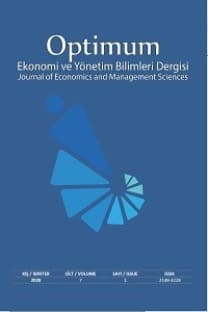Post Keynesyen Ekonominin Metodolojik Temelleri
Post Keynesyen Ekonomi, Metodoloji, Eleştirisel Realizm, Ergodik Olmayan Sistem
The Methodological Foundations of Post Keynesian Economics
___
- Arestis, P. (1992). The Post-Keynesian approach to economics: an alternative analysis of economic theory and policy. Aldershot: Edward Elgar Publishing.
- Arestis, P. (1997). Money, pricing, distribution and economic ıntegration. London: Macmillan Press.
- Ayata, S. (1987). Kapitalizm ve küçük üreticilik: Türkiye’deki halı dokumacılığı. Ankara: Yurt Yayınları.
- Brown, A. (2003). Critical realism. In J. E. King (Eds.), The Elgar companion to Post Keynesian economics. Edward Cheltenham: Elgar Publishing.
- Carabelli, A. M. & Cedrini, M. A. (2017). Keynes against Kalecki on economic method. Journal of Post Keynesian Economics, Vol. 40, No. 3.
- Davidson, P. (1980). Post Keynesian economics: solving the crisis in economic theory. The Public Interest, Special Edition.
- Davidson, P. (1994). Post Keynesian macroeconomic theory: a foundation for successful economic policies for the twenty-first century. Cheltenham: Edward Elgar Publishing.
- Davidson, P. (2003). Setting the record straight on a history of Post Keynesian economics. Journal of Post Keynesian Economics, Vol. 26, No. 2.
- Dow, S. (1991). The Post-Keynesian school. In D. Mair & A. G. Miller (Eds.). Edward Elgar, A modern guide to macroeconomic thought, Aldershot: Edward Elgar Publishing.
- Dow, S. (2001). The Post Keynesian methodology. In R. Holt & S. Pressman (Eds.), A new guide to Post Keynesian economics, London: Routledge.
- Downward, P. (1999). Pricing theory in Post Keynesian economics. Cheltenham: Edward Elgar.
- Downward, P. (2003). Econometrics. In J. E. King (Eds.), The Elgar companion to Post Keynesian economics. Cheltenham: Edward Elgar.
- Drakopoulos, S. A. (1999). Post-Keynesian choice theory. In P. A. O’Hara (Eds.), Encyclopedia of political economy, Vol. 2, London: Routledge.
- Gerrard, B. (1996). Competing schools of thought in macroeconomics-an ever-emerging consensus. Journal of Economic Studies, Vol. 23, No. 1.
- Hart, N. & Kriesler, P. (2014). Keynes, Kalecki, Sraffa: coherence?. Australian School of Business Research Paper, No. 2014 ECON 06.
- Hart, N. & Kriesler, P. (2015). Post-Keynesian economics: A user’s guide. The Australian Economic Review, Vol. 48, No: 3.
- King, J. E. (2002). A history of Post Keynesian economics Since 1936. Cheltenham: Edward Elgar Publishing.
- King, J. E. (2013). A brief introduction to Post Keynesian macroeconomics. Wirtschaft und Gesellschaft, 39. Jahrgang, Heft 4.
- Lavoie, M. (1992). Foundations of Post-Keynesian economic analysis. Aldershot: Edward Elgar Publishing.
- Lawson, T. (1997). Economics and reality. London: Routledge Publishing.
- Robinson, J. (1962). Essays in the theory of economic growth. London: Macmillan.
- Setterfield, M. (1995). Historical time and economic theory. Review of Political Economy, 7(1).
- Seyidoğlu, H. (1999). İngilizce-Türkçe ekonomi ve işletmecilik terimleri açıklamalı sözlük. İstanbul: Güzem Can Yayınları.
- Yayın Aralığı: Yılda 2 Sayı
- Başlangıç: 2014
- Yayıncı: -
TL / ABD Doları Döviz Kuru Belirlenme Modeli: ARDL Sınır Testi Uygulaması
Orta Gelir Tuzağının Türkiye Geneli ve Düzey Alt Bölgeleri İçin Tespiti
Post Keynesyen Ekonominin Metodolojik Temelleri
Adalet Hizmetlerinde Beklenti Çıpası ve Beklenti Yanlışlaması Hipotezleri: Türkiye Örneği
Sevilay Ece GÜMÜŞ ÖZUYAR, Alparslan Abdurrahman BAŞARAN, Necmiddin BAĞDADİOĞLU
Vergi Aflarına Yönelik Mükellef Görüşleri ve Sosyo-Ekonomik Faktörlere İlişkin Bir Analiz
Zehra Berna AYDIN, Zuhal AKBELEN
Bankalarda Amacına Göre İç Denetim: Türkiye Bankacılık Sektörü Özelinde Örnek Denetim Vakaları
Sistematik Riskin Hisse Senedi Getirisine Etkisi: Borsa İstanbul Örneği
Timuçin DALGIÇ, Muhammet Ali TİLTAY
İstihdam Yaratmayan Ekonomik Büyüme: Türkiye İçin Okun Yasası Çerçevesinde Ekonometrik Bir Analiz
